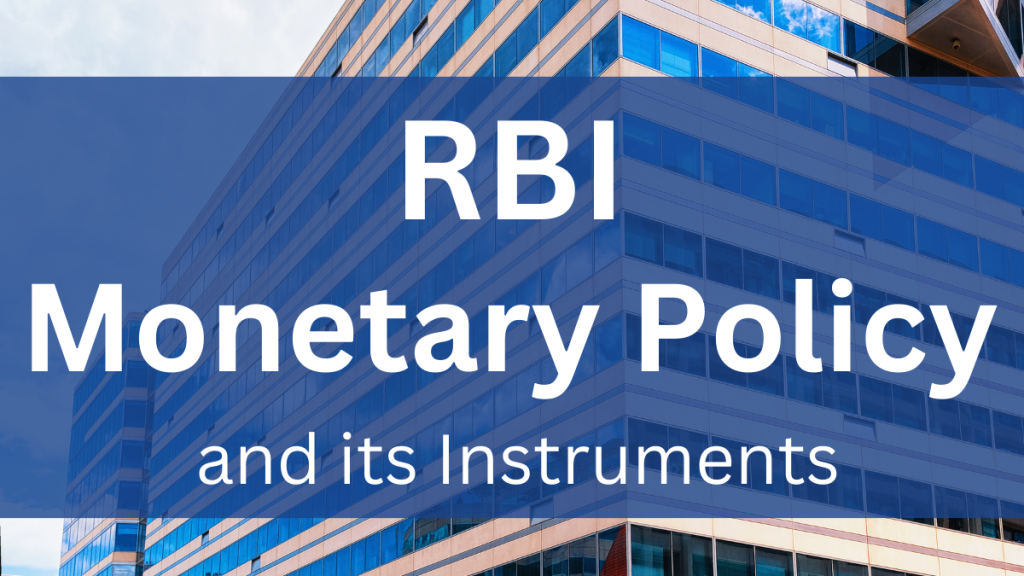The Reserve Bank of India (RBI) was established in 1935 and plays an important role in the Indian monetary system. It is the main financial support of the economy. One of the most important functions for this is called budgeting. This is a technique of controlling the amount of money floating around, interest rates, and price stability. The RBI’s job is to stabilize the economy, help it grow and make sure everything is safe in the world of money.
Creating Monetary policies is the major function of RBI. It is a powerful tool to control many important financial products in India. People talk about it a lot because it affects so many aspects of the economy. This blog post is a journey to discover what budgeting really is. We will discuss about factors like Repo Rate, Reverse Repo Rate, Cash Reserve Ratio, and try to explain in a simple way how RBI uses it to make its policy work.

Understanding the RBI and Its Need
The Reserve Bank of India was founded in 1935. It is India’s most important financial organization. The RBI controls India’s money and economy. It operates under the Reserve Bank of India Act from 1934. The RBI oversees Indian money production and circulation. It also protects the financial system and keeps the economy stable.
The RBI’s primary task involves formulating and implementing India’s Monetary Policy. This crucial tool enables the central bank to regulate key economic factors. These include money supply levels, interest rates, and inflation rates. This important tool helps the central bank control important economic factors like how much money is out there, interest rates, and inflation. By using tools like the Repo Rate, Reverse Repo Rate, and different reserve requirements, the RBI manages the tricky job of handling the economy. It works closely with the government to meet big economic goals and build a strong financial system.
Objectives of RBI’s Monetary Policy
RBI’s monetary policy is like a toolbox with many tools to help the economy grow and keep prices stable. Its primary goal is to control inflation so that your money can buy what you need, manage interest rates smartly to grow the economy, and create more jobs. By carefully balancing these objectives, the RBI aims to build a strong economy capable of handling changes and challenges effectively. Here are the main objectives of the RBI monetary policy:
Price Stability
Maintaining inflation is a key objective of the RBI’s monetary policy. The central bank works hard to ensure that inflation remains stable because stable inflation is absolutely necessary for a healthy economy. This is not just about following the rules; Stabilizing India’s currency is essential to support long-term economic growth Good price controls give people and businesses the confidence to plan and act, underpinning a strong and prosperous economy
Economic Growth
RBI is committed to sustainable and equitable economic growth. A big part of this is keeping interest rates down and making sure there is enough credit. The goal is to encourage both business and the public to invest and spend. By creating prices and facilitating access to credit, the RBI helps boost economic activity. This framework is key to improving balanced and inclusive growth by recognizing how all sectors of the economy are interconnected.
Employment Generation
RBI wants to create an environment that not only promotes economic growth but also creates more jobs. To do this, they have to balance things like keeping prices stable with ensuring there are enough job opportunities. The RBI knows that inflation and labor market controls go hand in hand, so it works towards achieving both objectives without sacrificing one. This shows how RBI is committed to formulate policies that will not only provide financial stability but also benefit Indians socio-economically.
Instruments of RBI’s Monetary Policy
The RBI uses various instruments to effectively implement its monetary policy. These instruments are, repo rate, reverse repo rate, cash on reserve ratio (CRR), and open market operations (OMO). By using these tools carefully, the RBI aims to influence factors such as the quantity of money out there, interest rates and inflation, all of which are consistent with its larger picture objectives. Let’s take a closer look at these important tools:
- Repo Rate: Repo rate is an important tool for RBI. Similar to RBI interest rates when it lends money to commercial banks for a short period of time, a rise in the repo rate for about 1-2 weeks makes lending money more expensive for banks, helping to lift the amount of money floating on it reduce and restrain inflation but falling repo rate makes credit easier, which Can boost economic activity and support economic growth. This tweaking of interest rates is really important for managing the economic situation.
- Reverse Repo Rate: Reverse repo rate is another important aspect of RBI’s monetary policy. RBI appears to be borrowing from interest-paying commercial banks. This rate helps determine how much money is in the system. When the reverse repo rate increases, it encourages banks to send more money to the RBI instead of borrowing elsewhere. This helps reduce the overall amount of money circulating in the economy. By tweaking the reverse repo rate, the RBI can control the money supply to better meet its macroeconomic objectives.
- Cash Reserve Rate (CRR): Cash Reserve Rate (CRR) is like the portion of a bank’s cash that it has to keep in cash with the RBI. This regulation can control the amount of money that banks can lend. When the CRR goes up, banks have to keep excess cash with the RBI, which means they have got far less money to lend. This slows down lending and can affect economic interests. Thus, CRR is a big deal for RBI in terms of regulating access to tons of cash in banking machines.
- Statutory Reserve Reserve (SLR): Statutory Reserve Reserve (SLR) is the portion of a bank’s total deposits that are required by authorities to be deposited in accredited bank accounts. Like the amount of reserves ( .Repo Rate: Repo rate is an important tool for RBI. Similar to RBI’s interest rate hike when it lends to commercial banks for a short period of time, the rise in repo rates for about 1-2 weeks makes lending money more expensive for banks, contributing to the volatility of the money supply decrease and restrain inflation but falling repo rates make credit easier , a It can boost economic activity and support economic growth This interest rate adjustment is really important for managing the monetary situation.
- Reverse Repo Rate: Reverse repo rate is another important aspect of RBI’s monetary policy. RBI appears to be borrowing from interest-paying commercial banks. This rate helps determine how much money is in the system. When the reverse repo rate increases, it encourages banks to send more money to the RBI instead of borrowing elsewhere. This helps reduce the overall amount of money circulating in the economy. By tweaking the reverse repo rate, the RBI can control the money supply to better meet its macroeconomic objectives.
- Cash Reserve Rate (CRR): Cash Reserve Rate (CRR) is like the portion of a bank’s cash that it has to keep in cash with the RBI. This regulation can control the amount of money that banks can lend. When the CRR goes up, banks have to keep excess cash with the RBI, which means they have got far less money to lend. This slows down lending and can affect economic interests. Thus, CRR is a big deal for RBI in terms of regulating access to tons of cash in banking machines.
- Statutory Reserve Reserve (SLR): Statutory Reserve Reserve (SLR) is the portion of a bank’s total deposits that are required by authorities to be deposited in accredited bank accounts.
Impact of RBI’s Monetary Policy on the Economy:
The decisions made by the Reserve Bank of India regarding its Monetary Policy have big effects on the Indian economy. They affect things like interest rates, how much it costs to borrow money, inflation, and the value of the currency. These decisions also have a big impact on financial markets, influencing things like stock prices and bond yields. Additionally, how easy it is to get credit, how confident businesses and consumers feel, and overall economic activity are all closely tied to the central bank’s decisions. This shows how important and wide-reaching the effects of the RBI’s Monetary Policy can be.
- Interest and borrowing costs: Changes in the repo rate have a direct impact on interest rates in the economy. When the repo rate is low, which is what RBI lends to commercial banks, the loan is cheaper. This encourages people to save and spend more, boosting the economy. On the other hand, when the repo rate rises, the cost of borrowing rises, which can slow economic growth. Higher interest rates make borrowing less attractive, leading to lower investment and lower spending. Thus, careful manipulation of the repo rate is quite important as it affects the amount of credit and ultimately the pace of economic growth.
- Controlling inflation: The Reserve Bank of India’s (RBI) main strategy to curb inflation is through interest rate adjustment. If inflation becomes a problem, the RBI may decide to raise interest rates. This helps lower deficits by making borrowing more affordable. On the other hand, when the RBI cuts interest rates, it tries to encourage more spending and investment, which can boost economic activity. The RBI’s cautious use of interest rates reflects its efforts to strike a balance between controlling inflation and stimulating the economy.
- Currency Value: The Reserve Bank of India is carefully considering the impact of its monetary policy on the exchange rate of the Indian rupee. When the RBI raises interest rates as part of its policy, it tends to attract foreign investors looking for better returns. This increased demand for the rupee could strengthen it, giving it a boost. But if the RBI wants to deliberately weaken the rupee, it could create more competition in the country and help boost exports. This strategic exchange rate as part of monetary policy is crucial in shaping India’s trade relations and overall economic growth.
- Financial markets: Monetary decisions are heavily influenced by financial market behavior in India. When the Reserve Bank of India changes the interest rate, which is one of its key tools, it affects a wide range of economic issues. These changes can affect how the market reacts to stock prices, bond yields, and other characteristics. Investors are closely watching the RBI announcements for possible changes in monetary policy, as the decision may just shake up the market. The relationship between the decisions taken by the central bank and the reaction of the financial markets indicates the importance of the RBI in the overall direction of the Indian economy.
- Credit Availability: Cash Reserve Ratio (CRR) and Statutory Liquidity Ratio (SLR) are important for the amount of credit available to banks in India. This rule determines how much of a bank’s reserves must be invested in cash (CRR) or special government-approved bonds (SLR). When this rule changes, it affects how much money banks can lend. Thus, fluctuations in CRR and SLR can have an impact on the amount of money that lending banks can lend, which in turn affects the pace of economic growth. The Reserve Bank of India carefully tweaks these rules to control the amount of money in the banking system.
- Business and Consumer Confidence: A clear and consistent monetary policy is absolutely necessary to build trust between businesses and consumers in India. When policies are flexible and people are predictable, it helps create a stable economy. This relief encourages companies to invest wisely and gives consumers the confidence to spend. Knowing that policies will not suddenly change reduces uncertainty, which is good for sustaining strong economic growth. The Reserve Bank of India’s commitment to clear and stable monetary policy actions enables the economy to bounce back from challenges and creates a greater sense of security for all, which is great for growing businesses and consumer spending . . . .
Recent Trends and Challenges
In recent times, the RBI has faced some serious challenges in the effective implementation of its monetary policy. The COVID-19 pandemic brought about some major changes. To help, the RBI took steps like injecting more money into the system, with some rules being made more stringent and targeted loans to certain sectors. These steps were aimed at mitigating the impact of the pandemic on the economy and strengthening India’s monetary policy.
Another challenge is finding the right balance between increasing economic growth and maintaining inflation. This is important because no one wants a situation where the economy remains stagnant and prices rise. RBI needs to take a wise decision to avoid this predicament. Also, what happens in other countries affects us too. Changes in exchange rates, trade and global interest rates can all affect the Indian economy. Hence, RBI should take into consideration this information while formulating policies. Finally, with the rise in popularity of digital currencies and other financial technologies, the RBI also needs to adapt. It needs to implement new technologies to ensure that its systems work smoothly in the digital age. Being flexible and tracking these changes is key to ensuring that India’s financial systems remain efficient and supportive.
Summing Up
The Reserve Bank of India’s monetary policy is similar to the way the country’s economy is run. This includes things like changing interest rates, controlling the amount of money available, and regulating banks. The goal is to keep prices stable and ensure continued economic growth. However, in a rapidly changing world, the RBI has to keep pace with new trends and use digital tools. The balance is absolutely necessary to control inflation and promote economic growth. Understanding how these policies work gives a better idea of how the Indian economy works and shows how the RBI’s strategies are shaping where the country is headed.
Preparing for the RBI Grade A Exam? Boost your success with ixamBee’s RBI Grade A\B Online Course, designed by experts to cover the entire syllabus with interactive lessons and study notes. Enhance your practice with RBI Grade B Mock Tests and RBI Grade B Phase 1 PYP for real exam insights. Also, explore our Target Banking Online Course for comprehensive banking exam preparation. Start your journey with ixamBee today!
ixamBee specializes in providing expert guidance and resources for banking exams 2025, ensuring that you are well-prepared for the Upcoming Bank Exams like RBI Grade B, NABARD Grade B, IBPS SO, and more. Our courses align with the bank exam calendar 2024, covering all the essential topics. With a focus on the upcoming bank jobs, our Previous Year Papers, BeePedia, SSC CGL, SSC CHSL, SSC MTS and other Mock Tests are designed to help you excel in upcoming banking exams.
Also Read:
How to Decide Which Government Exam You Should Prepare For?
Breaking Down the Economic and Social Issues in RBI Grade B Examination
How to Prepare for IBPS RRB Exam 2025














